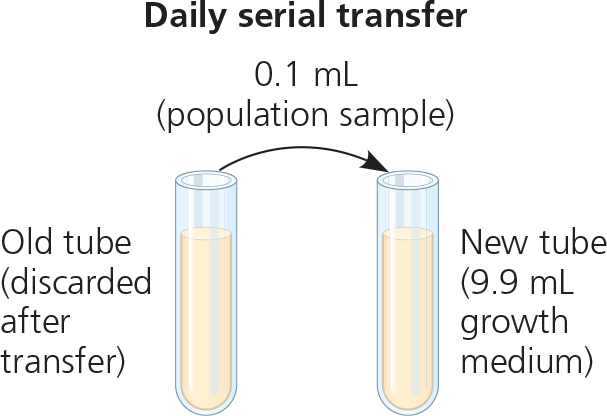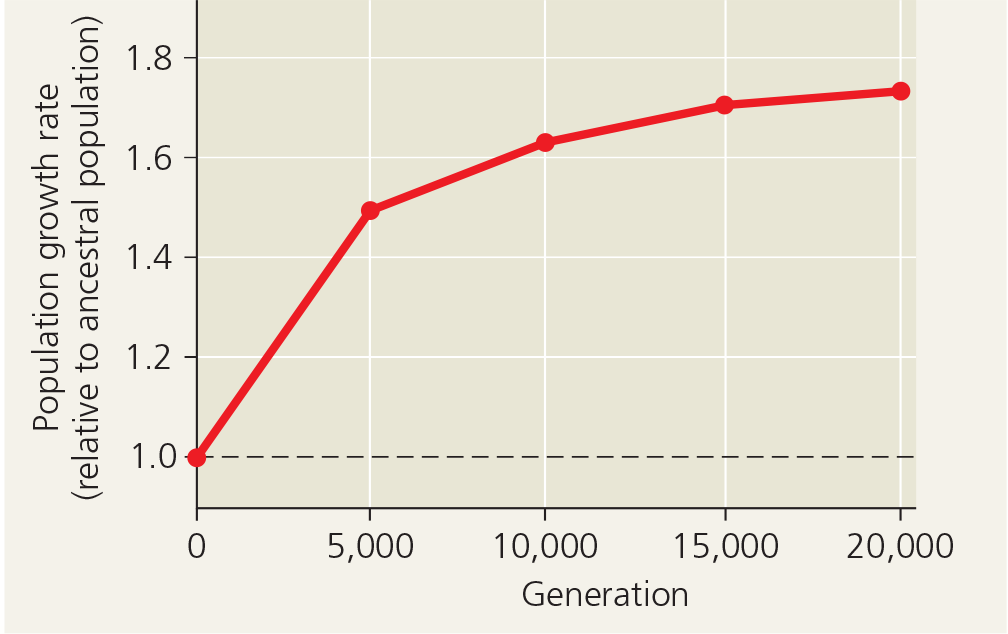😫AP BIO Chapter 24 - Early Life and the Diversification of Prokaryotes
Overview
24.1 Conditions on early Earth made the origin of life possible
24.2 Diverse structural and metabolic adaptations have evolved in prokaryotes
24.3 Rapid reproduction, mutation, and genetic recombination promote genetic diversity in prokaryotes
24.4 Prokaryotes have radiated into a diverse set of lineages
24.5 Prokaryotes play crucial roles in the biosphere
BIG IDEAS: Evidence supports the evolution of complex structures and processes in prokaryotes (Big Idea 1) that use free energy to support growth, reproduction, and dynamic homeostasis (Big Idea 2). Having evolved through rapid genetic change (Big Idea 3), diverse forms of prokaryotes interact with other organisms and play crucial roles in the biosphere (Big Idea 4)
[[Prokaryote:[[
An organism that has a prokaryotic cell; an informal term for single-celled organisms in domains Bacteria and Archaea
Their ability to live in a ___ range of habitats helps explain why prokaryotes are the most abundant organisms on Earth
broad
Bacteria that inhabit the human body - Touching an agar gel led to the handprint-shaped growth of Staphylococcus epidermidis, just one of more than 1,000 species of bacteria that live on or in the human body
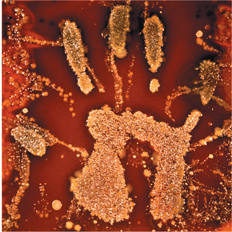
^^24.1 - Conditions on early Earth made the origin of life possible^^
Experiments simulating possible early atmospheres have produced organic molecules from inorganic precursors. Amino acids, lipids, sugars, and nitrogenous bases have also been found in meteorites
Amino acids and RNA nucleotides polymerize when dripped onto hot sand, clay, or rock. Organic compounds can spontaneously assemble into protocells, membrane-bounded droplets that have some properties of cells
The first genetic material may have been self-replicating, catalytic RNA. Early protocells containing such RNA would have increased in abundance through natural selection
Fossil evidence of early prokaryotes dates to 3.5 billion years ago. By 2.8 billion years ago, prokaryotes included stromatolites that differed in morphology and habitat. Early prokaryotes also included cyanobacteria that released oxygen as a by-product of photosynthesis, thereby changing Earth’s atmosphere and altering the course of evolution
What are the four main stages of producing simple cells?

[[Protocells:[[
An abiotic precursor of a living cell that had a membrane-like structure and that maintained internal chemistry different from that of its surroundings
Amino acid synthesis in a simulated volcanic eruption - In addition to his classic 1953 study, Miller also conducted an experiment simulating a volcanic eruption. In a 2008 reanalysis of those results, researchers found that far more amino acids were produced under simulated volcanic conditions than were produced in the conditions of the original 1953 experiment
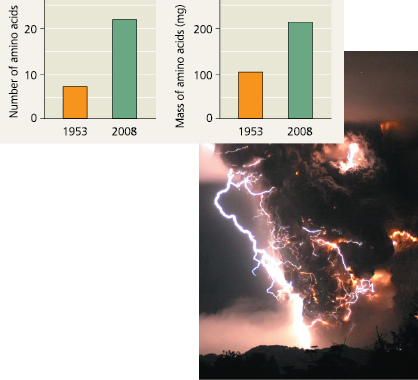
^^Explain how more than 20 amino acids could have been produced in the 2008 experiment^^
Proteins are almost always composed of the same 20 amino acids shown in Figure 3.18. However, many other amino acids could potentially form in this or any other experiment. For example, any molecule that had a different R group than those listed in Figure 3.18 in the 20 most common amino acids (yet still contained an α carbon, an amino group, and a carboxyl group) would be an amino acid—yet it would not be one of the 20 amino acids commonly found in nature today
Every cell has many types of ___, including enzymes and other proteins and the nucleic acids needed for self-replication
macromolecules
All organisms must be able to carry out ___
_
reproduction and energy processing (metabolism)
[[Vesicles:[[
Fluid-filled compartment encoded by a membrane-like structure
Abiotically produced vesicles

^^Explain how molecules with both a hydrophobic region and a hydrophilic region can self-assemble into a bilayer when in water^^
The hydrophobic regions of such molecules are attracted to one another and excluded from water, whereas the hydrophilic regions have an affinity for water. As a result, the molecules can form a bilayer in which the hydrophilic regions are on the outside of the bilayer (facing water on each side of the bilayer) and the hydrophobic regions point toward each other (that is, toward the inside of the bilayer)
[[Ribozyme:[[
An RNA molecule that functions as an enzyme, such as an intron that catalyzes its own removal during RNA splicing
The first genetic material was most likely ___, not DNA. It plays a central role in protein synthesis, but it can also function as an enzyme-like catalyst
RNA
Appearance in the fossil record of early prokaryote groups
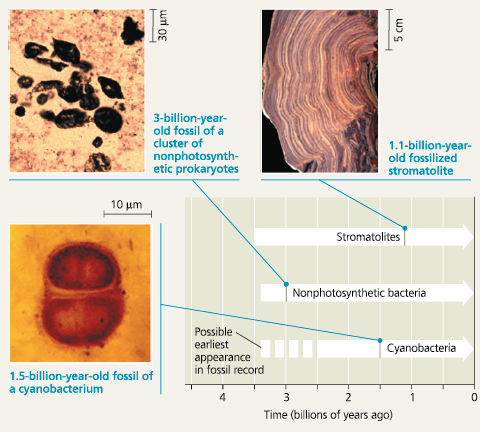
^^What hypothesis did Miller test in his classic experiment?^^
The hypothesis that conditions on early Earth could have permitted the synthesis of organic molecules from inorganic ingredients
^^How would the appearance of protocells have represented a key step in the origin of life?^^
In contrast to random mingling of molecules in an open solution, segregation of molecular systems by the membranes of protocells could concentrate organic molecules, assisting biochemical reactions
^^Summarize fossil evidence of early prokaryotes. Describe how these organisms altered Earth’s atmosphere^^
The earliest prokaryotic fossils are of stromatolites that lived in shallow marine environments 3.5 billion years ago. By 3.1 billion years ago, stromatolites had diversified into two different morphological types, and by 2.8 billion years ago, they had expanded to live in salty lakes as well as marine environments. Fossils of individual prokaryotic cells have also been found, the earliest dating to 3.4 billion years ago. By 2.5 billion years ago, diverse communities of photosynthetic cyanobacteria lived in the oceans. These cyanobacteria released oxygen to Earth’s atmosphere during the water-splitting step of photosynthesis. As a result, the composition of the atmosphere changed, and many prokaryotic groups were driven to extinction—thus altering the course of evolution
^^In changing from an “RNA world” to today’s “DNA world,” genetic information must have flowed from RNA to DNA. After reviewing Figures 14.4 and 17.7, suggest how this could have occurred. Suggest how this could have occurred. Does such a flow occur today?^^
Today, genetic information usually flows from DNA to RNA, as when the DNA sequence of a gene is used as a template to synthesize the mRNA encoding a particular protein. However, the life cycle of retroviruses such as HIV shows that genetic information can flow in the reverse direction (from RNA to DNA). In these viruses, the enzyme reverse transcriptase uses RNA as a template for DNA synthesis, suggesting that a similar enzyme could have played a key role in the transition from an RNA world to a DNA world
^^Describe the roles that montmorillonite clay and vesicles may have played in the origin of life^^
Particles of montmorillonite clay may have provided surfaces on which organic molecules became concentrated and hence were more likely to react with one another. Montmorillonite clay particles may also have facilitated the transport of key molecules, such as short strands of RNA, into vesicles. These vesicles can form spontaneously from simple precursor molecules, “reproduce” and “grow” on their own, and maintain internal concentrations of molecules that differ from those in the surrounding environment. These features of vesicles represent key steps in the emergence of protocells and (ultimately) the first living cells
^^24.2 - Diverse structural and metabolic adaptations have evolved in prokaryotes^^
Nutritional diversity is much greater in prokaryotes than in eukaryotes. As a group, prokaryotes perform all four modes of nutrition: photoautotrophy, chemoautotrophy, photoheterotrophy, and chemoheterotrophy
Among prokaryotes, obligate aerobes require O2, obligate anaerobes are poisoned by O2, and facultative anaerobes can survive with or without O2
Unlike eukaryotes, prokaryotes can metabolize nitrogen in many different forms. Some can convert atmospheric nitrogen to ammonia, a process called nitrogen fixation
Prokaryotic cells and even species may cooperate metabolically. In Anabaena, photosynthetic cells and nitrogen-fixing cells exchange metabolic products. Metabolic cooperation also occurs in surface-coating biofilms that include different species
Prokaryotes can reproduce quickly by binary fission, leading to the formation of populations containing enormous numbers of individuals. Some form endospores, which can remain viable in harsh conditions for centuries
However, prokaryotic populations have also evolved in ways that cannot be seen in the fossil record, including changes in ___
the type and efficiency of their enzymes
Prokaryote shapes - (a) Cocci (singular, coccus) are spherical prokaryotes. They occur singly, in pairs (diplococci), in chains of many cells (streptococci), and in clusters resembling bunches of grapes (staphylococci). (b) Bacilli (singular, bacillus) are rod-shaped prokaryotes. They are usually solitary, but in some forms the rods are arranged in chains (streptobacilli). (c) Spiral prokaryotes include spirilla, which range from comma-like shapes to loose coils, and spirochetes (shown here), which are corkscrew-shaped (colorized SEMs)

In eukaryotes that have cell walls, such as plants and fungi, the walls are usually made of ___
cellulose or chitin
[[Peptidoglycan:[[
A type of polymer in bacterial cell walls consisting of modified sugars cross-linked by short polypeptides
[[Gram-Positive:[[
Describing the group of bacteria that have a cell wall that is structurally less complex and contains more peptidoglycan and usually is less toxic than gram-negative bacteria
[[Gram-Negative:[[
Describing the group of bacteria that have a cell wall that is structurally more complex and contains less peptidoglycan and usually is more toxic than gram-negative bacteria
Gram staining

Capsule:
A dense and well-defined layer of polysaccharide or protein that surrounds the cell wall and is sticky, protecting the cell and enabling it to adhere to substrates or other cells
Capsule - The polysaccharide capsule around this Streptococcus bacterium enables the prokaryote to attach to cells in the respiratory tract—in this colorized TEM, a tonsil cell
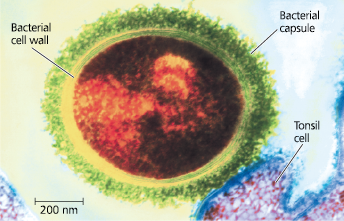
[[Endospore:[[
A thick-coated, resistant cell produced by some bacterial cells when they are exposed to harsh condition
[[Fimbria:[[
A short, hairlike appendage of a prokaryotic cell that helps it adhere to the substrate or to other cells
[[Pilus:[[
In bacteria, a structure that links one cell to another at the start of conjugation; also known as a sex pilus or conjugation pilus
Fimbriae - These numerous protein-containing appendages enable some prokaryotes to attach to surfaces or to other cells (colorized TEM)

[[Taxis:[[
An oriented movement toward or away from a stimulus
Prokaryotes move toward a stimulus in ___ and away in _ chemotaxis
positive; negative
[[Flagellum:[[
A long cellular appendage specialized for locomotion.
What shows that the flagella of bacteria, archaea, and eukaryotes arose independently?
Prokaryotic flagella differ greatly from eukaryotic flagella: They are one-tenth the width and typically are not covered by an extension of the plasma membrane (see Figure 4.23). The flagella of prokaryotes and eukaryotes also differ in their molecular composition and their mechanism of propulsion. Among prokaryotes, bacterial and archaeal flagella are similar in size and rotational mechanism, but they are composed of entirely different and unrelated proteins; In other words
Are flagella of organisms analogous or homologous?
Analogous - They have similar functions but not related by common descent
A prokaryotic flagellum - The motor of a prokaryotic flagellum consists of a system of rings embedded in the cell wall and plasma membrane (TEM). The electron transport chain pumps protons out of the cell. The diffusion of protons back into the cell provides the force that turns a curved hook and thereby causes the attached filament to rotate and propel the cell (This diagram shows flagellar structures characteristic of gram-negative bacteria)
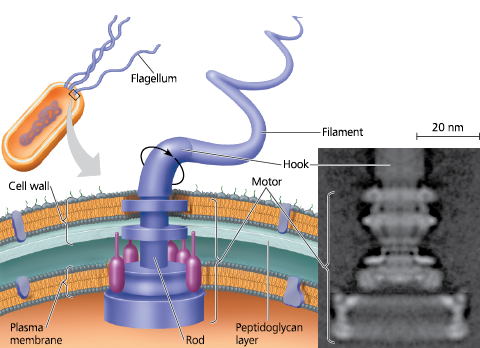
___ cells lack the complex compartmentalization associated with the membrane-enclosed organelles found in _ cells
prokaryotic; eukaryotic
Specialized membranes of prokaryotes - (a) Infoldings of the plasma membrane, reminiscent of the cristae of mitochondria, function in cellular respiration in some aerobic prokaryotes (TEM). (b) Photosynthetic prokaryotes called cyanobacteria have thylakoid membranes, much like those in chloroplasts (TEM)
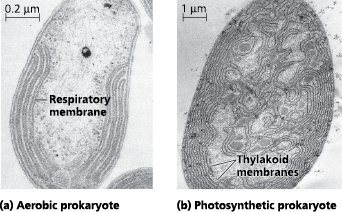
___ generally have circular chromosomes, in most cases have less DNA, the chromosome is associated with many fewer proteins, and may have nucleoids and plasmids
prokaryotes
___ have linear chromosomes and have a nucleus
eukaryotes
[[Nucleoid:[[
A non-membrane-enclosed region in a prokaryotic cell where its chromosome is located
[[Plasmid:[[
A small, circular, double-stranded DNA molecule that carries accessory genes separate from those of a bacterial chromosome; in DNA clinging, can be used as a vector carrying up to about 10,000 base pairs (10 kb) of DNA
A prokaryotic chromosome and plasmids - The thin, tangled loops surrounding this ruptured E. coli cell are parts of the cell’s large, circular chromosome (colorized TEM). Three of the cell’s plasmids, the much smaller rings of DNA, are also shown

___ have an astounding range of metabolic adaptations, much broader than that found in _
prokaryotes; eukaryotes
[[Phototrophs:[[
Organisms that obtain energy from light
[[Chemotrophs:[[
Organisms that obtain energy from chemicals
[[Autotrophs:[[
Organisms that only need CO2 or related compounds as a carbon source
[[Heterotrophs:[[
Organisms that require at least one organic nutrient, such as glucose, to make other organic compounds
Major Nutritional Modes

[[Obligate Aerobes:[[
Organisms that must use O2 for cellular respiration and cannot grow without it
[[Obligate anaerobes:[[
Organisms that are poisoned by O2
[[Anaerobic Respiration:[[
A catabolic pathway in which inorganic molecules other than oxygen accept electrons at the “downhill” end of electron transport chains
[[Nitorgen Fixation:[[
The conversion of atmospheric nitrogen (N2) to ammonia (NH3). Biological nitrogen fixation is carried out by certain prokaryotes, some of which have mutualistic relationships with plants
[[Heterocyst:[[
A specialized cell that engages in nitrogen fixation in some filamentous cyanobacteria; also called a heterocyte
Metabolic cooperation in a prokaryote - In the filamentous cyanobacterium Anabaena, cells called heterocysts fix nitrogen, while the other cells carry out photosynthesis (LM). Anabaena is found in many freshwater lakes
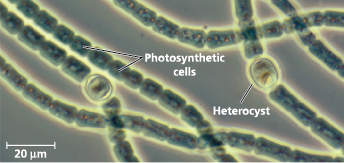
[[Biofilm:[[
A surface-coating colony of one or more species of prokaryotes that engage in metabolic cooperation
Many prokaryotes can reproduce ___ in favorable environments
quickly
Bacterial cell division by binary fission - The bacterium E. coli, shown here, has a single, circular chromosome
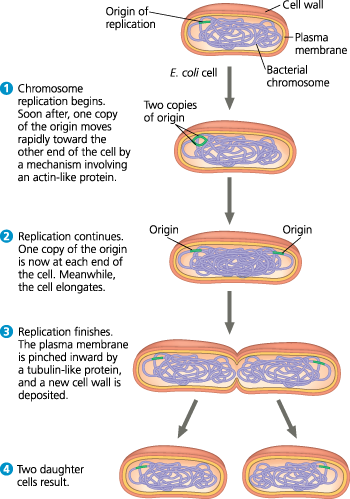
[[Binary Fission:[[
A method of asexual reproduction in single-celled organisms in which the cell grows to roughly double its size and then divides into two cells. In prokaryotes, binary fission does not involve mitosis, but in single-celled eukaryotes that undergo binary fission, mitosis is part of the process
[[Origin of Replication:[[
Site where the replication of a DNA molecule begins, consisting of a specific sequence of nucleotides
What prevents prokaryotes from giving rise to a large colony in a few days?
The cells eventually exhaust their nutrient supply, poison themselves with metabolic wastes, face competition from other microorganisms, or are consumed by other organisms
Three key features of prokaryotes -
They are small, they reproduce by binary fission, and they often have short generation times
^^Contrast the cellular and DNA structures of prokaryotes and eukaryotes^^
Prokaryotic cells lack the complex compartmentalization associated with the membrane-enclosed organelles of eukaryotic cells. Prokaryotic genomes have much less DNA than eukaryotic genomes, and most of this DNA is contained in a single ring-shaped chromosome located in the nucleoid rather than within a true membrane-enclosed nucleus. In addition, many prokaryotes also have plasmids, small ring-shaped DNA molecules containing a few genes
^^Distinguish between the four major modes of nutrition, noting which are unique to prokaryotes^^
A phototroph derives its energy from light, while a chemotroph gets its energy from chemical sources. An autotroph derives its carbon from CO2, HCO3 −, or related compounds, while a heterotroph gets its carbon from organic nutrients such as glucose. Thus, there are four nutritional modes: photoautotrophic, photoheterotrophic (unique to prokaryotes), chemoautotrophic (unique to prokaryotes), and chemoheterotrophic
^^Suggest a hypothesis to explain why the thylakoid membranes of chloroplasts resemble those of cyanobacteria. Refer to Figures 4.16 and 20.21^^
Plastids such as chloroplasts are thought to have evolved from an endosymbiotic photosynthetic prokaryote. More specifically, the phylogenetic tree shown in Figure 20.21 indicates that plastids are closely related to cyanobacteria. Hence, we can hypothesize that the thylakoid membranes of chloroplasts resemble those of cyanobacteria because chloroplasts evolved from a cyanobacterial endosymbiont
^^Describe what you might eat for a typical meal if humans, like cyanobacteria, could fix nitrogen^^
If humans could fix nitrogen, we could build proteins using atmospheric N2 and hence would not need to eat high-protein foods such as meat, fish, or soy. Our diet would, however, need to include a source of carbon, along with minerals and water. Thus, a typical meal might consist of carbohydrates as a carbon source, along with fruits and vegetables to provide essential minerals (and additional carbon)
^^Describe features of prokaryotes that enable them to thrive in a wide range of different environments^^
Specific structural features that enable prokaryotes to thrive in diverse environments include their cell walls (which provide shape and protection), flagella (which function in directed movement), and ability to form capsules or endospores (both of which can protect against harsh conditions). Prokaryotes also have an exceptionally broad range of metabolic adaptations, enabling them to thrive in many different environments
^^24.3 - Rapid reproduction, mutation, and genetic recombination promote genetic diversity in prokaryotes^^
Because prokaryotes can often proliferate rapidly, mutations can quickly increase a population’s genetic variation. As a result, prokaryotic populations often can evolve in short periods of time in response to changing conditions
Genetic diversity in prokaryotes also can arise by recombination of the DNA from two different cells (via transformation, transduction, or conjugation). By transferring advantageous alleles, such as ones for antibiotic resistance, genetic recombination can promote adaptive evolution in prokaryotic populations
What are three factors that gave rise to high levels of genetic diversity in prokaryotes?
Rapid reproduction, mutation, and genetic recombination
What was Cooper and Lenski’s experiment?
Vaughn Cooper and Richard Lenski tested the ability of E. coli populations to adapt to a new environment. They established 12 populations, each founded by a single cell from an E. coli strain, and followed these populations for 20,000 generations (3,000 days). To maintain a continual supply of resources, each day the researchers performed a serial transfer: They transferred 0.1 mL of each population to a new tube containing 9.9 mL of fresh growth medium. The growth medium used throughout the experiment provided a challenging environment that contained only low levels of glucose and other resources needed for growth. Samples were periodically removed from the 12 populations and grown in competition with the common ancestral strain in the experimental (low-glucose) environment
What were the results of the experiment?
The fitness of the experimental populations, as measured by the growth rate of each population, increased rapidly for the first 5,000 generations (2 years) and more slowly for the next 15,000 generations. The graph shows the averages for the 12 populations
What was concluded from the experiment?
Populations of E. coli continued to accumulate beneficial mutations for 20,000 generations, allowing rapid evolution of increased population growth rates in their new environment
^^Suggest possible functions of the genes whose sequence or expression was altered as the experimental populations evolved in the low-glucose environment^^
It is likely that the expression or sequence of genes that affect glucose metabolism may have changed; genes for metabolic processes no longer needed by the cell also may have changed
Mutations, though rare on a per gene basis, can increase genetic diversity ___ in species with short generation times and large populations
quickly
[[Genetic Recombination:[[
The combining of DNA from two sources
Compare genetic recombination in prokaryotes and eukaryotes
Transformation, transduction, and conjugation can bring together prokaryotic DNA from different individuals (and results in horizontal gene transfer when the individuals are from different species). In eukaryotes, the sexual processes of meiosis and fertilization combine DNA from two individuals in a single zygote
[[Transformation:[[
The process by which a cell in culture acquires the ability to divide indefinitely, similar to the division of cancer cells; A change in genotype and phenotype due to the assimilation of external DNA by a cell
Transduction:
A process in which phages (viruses) carry bacterial DNA from one bacterial cell to another; in cellular communication, the conversion of a signal from outside the cell to a form that can bring about a specific cellular response; also called signal transduction
Transduction - Phages may carry pieces of a bacterial chromosome from one cell (the donor) to another (the recipient). If crossing over occurs after the transfer, genes from the donor may be incorporated into the recipient’s genome
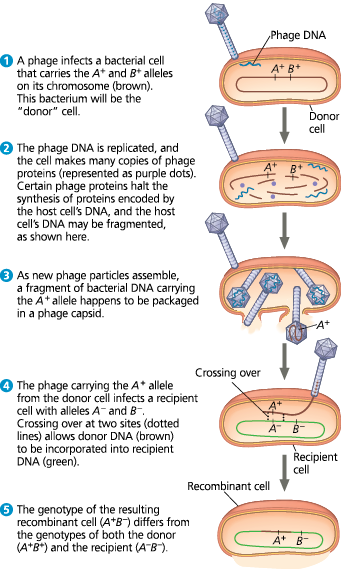
^^Under what circumstances would a transduction event result in horizontal gene transfer?^^
Transduction results in horizontal gene transfer when the host and recipient cells are members of different species
[[Conjugation:[[
In prkarotes, the direct transfer of DNA between two cells that are temporarily joined; In ciliates, a sexual process in which two cells exchange hapoid micronuclei but do not reproduce
Bacterial conjugation - The E. coli donor cell (left) extends a pilus that attaches to a recipient cell, a key first step in the transfer of DNA. The pilus is a flexible tube of protein subunits (TEM)
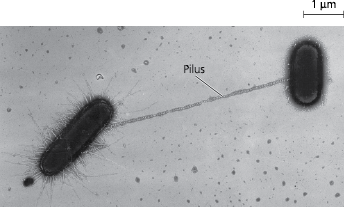
[[F Factor:[[
IN bacteria, the DNA segment that confers the ability to form pili for conjugation and associated function requires for the transfer of DNA from donor to recipient. The F factor may exist as a plasmid or be integrated into the bacterial chromosome
[[F Plasmid:[[
The plasmid form of the F factor
Conjugation and transfer of an F plasmid, resulting in recombination - The DNA replication that accompanies the transfer of an F plasmid is called rolling circle replication. In effect, the intact circular DNA strand from the donor cell’s F plasmid “rolls” as its other strand peels off and a new complementary strand is synthesized

[[R Plasmid:[[
A bacterial plasmid carrying genes that confer resistance to certain antibiotics
^^Although rare on a per gene basis, new mutations can add considerable genetic variation to prokaryotic populations in each generation. Explain how this occurs^^
Prokaryotes can have extremely large population sizes, in part because they often have short generation times. The large number of individuals in prokaryotic populations makes it likely that in each generation there will be many individuals that have new mutations at any particular gene, thereby adding considerable genetic diversity to the population
^^Distinguish between the three mechanisms by which bacteria can transfer DNA from one bacterial cell to another^^
In transformation, naked, foreign DNA from the environment is taken up by a bacterial cell. In transduction, phages carry bacterial genes from one bacterial cell to another. In conjugation, a bacterial cell directly transfers plasmid or chromosomal DNA to another cell via a mating bridge that temporarily connects the two cells
^^In a rapidly changing environment, which bacterial population would likely be more successful, one that includes individuals capable of conjugation or one that does not?^^
The population that includes individuals capable of conjugation would probably be more successful, since some of its members could form recombinant cells whose new gene combinations might be advantageous in a novel environment
^^If a nonpathogenic bacterium were to acquire resistance to antibiotics, could this strain pose a health risk to people? In general, how does DNA transfer among bacteria affect the spread of resistance genes?^^
Yes. Genes for antibiotic resistance could be transferred (by transformation, transduction, or conjugation) from the nonpathogenic bacterium to a pathogenic bacterium; this could make the pathogen an even greater threat to human health. In general, transformation, transduction, and conjugation tend to increase the spread of resistance genes
^^Mutations are rare and prokaryotes reproduce asexually, yet their populations can have high genetic diversity. Explain how this can occur^^
Many prokaryotic species can reproduce extremely rapidly, and their populations can number in the trillions. As a result, even though mutations are rare, every day many offspring are produced that have new mutations at particular gene loci. In addition, even though prokaryotes reproduce asexually and hence the vast majority of offspring are genetically identical to their parent, the genetic variation of their populations can be increased by transduction, transformation, and conjugation. Each of these (nonreproductive) processes can increase genetic variation by transferring DNA from one cell to another—even among cells that are of different species
^^24.4 - Prokaryotes have radiated into a diverse set of lineages^^
Molecular systematics is helping biologists classify prokaryotes and identify major new clades
Diverse nutritional types are scattered among the major groups of bacteria. The two largest groups are the proteobacteria and gram-positive bacteria
Some archaea, such as extreme thermophiles and extreme halophiles, live in extreme environments. Other archaea live in moderate environments, such as soils and lakes
What’s the cause of adding the domain Achaea?
Researchers concluded that many prokaryotes once classified as bacteria are actually more closely related to eukaryotes and belong in a domain of their own
A simplified phylogeny of prokaryotes - This phylogenetic tree based on molecular data shows one of several debated hypotheses of the relationships between the major prokaryotic groups discussed in this chapter. Within Archaea, the placement of the korarchaeotes and nanoarchaeotes remains unclear
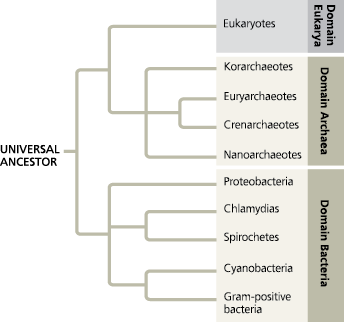
^^Which domain is the sister group of Archaea?^^
Eukarya
Significant portions of the genomes of many prokaryotes are actually mosaics of genes imported from other species due to ___
horizontal transfer
Exploring Selected Major Groups of Bacteria
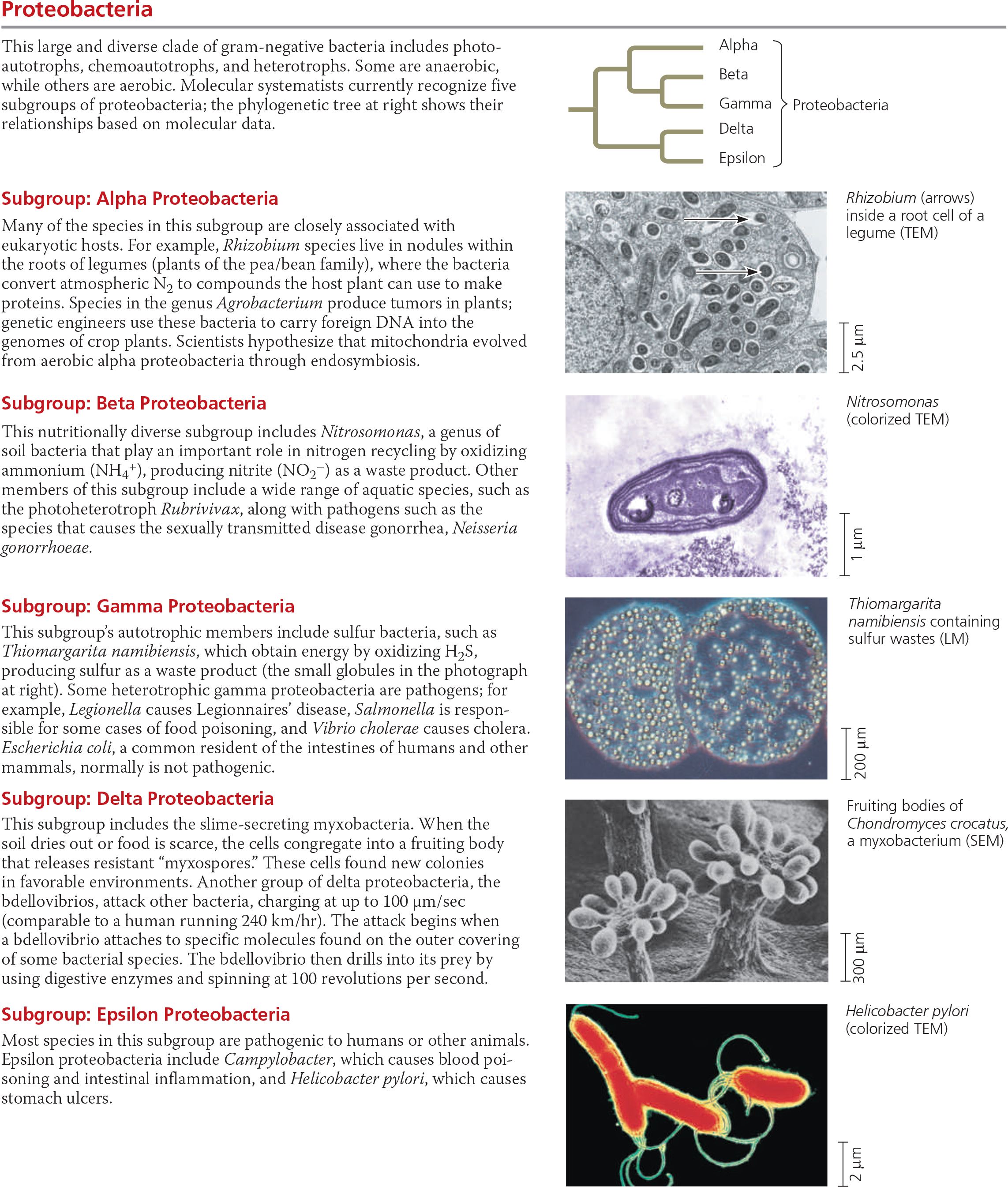
More Major Groups of Bacteria
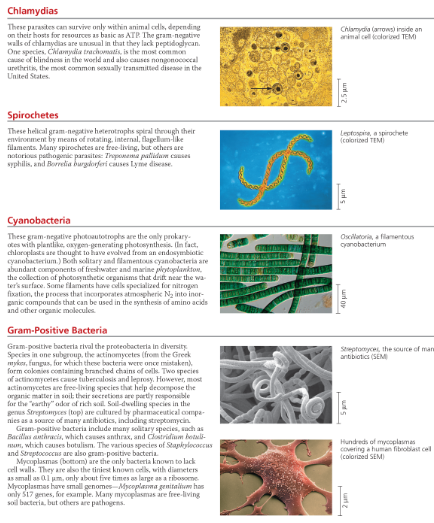
A Comparison of the Three Domains of Life
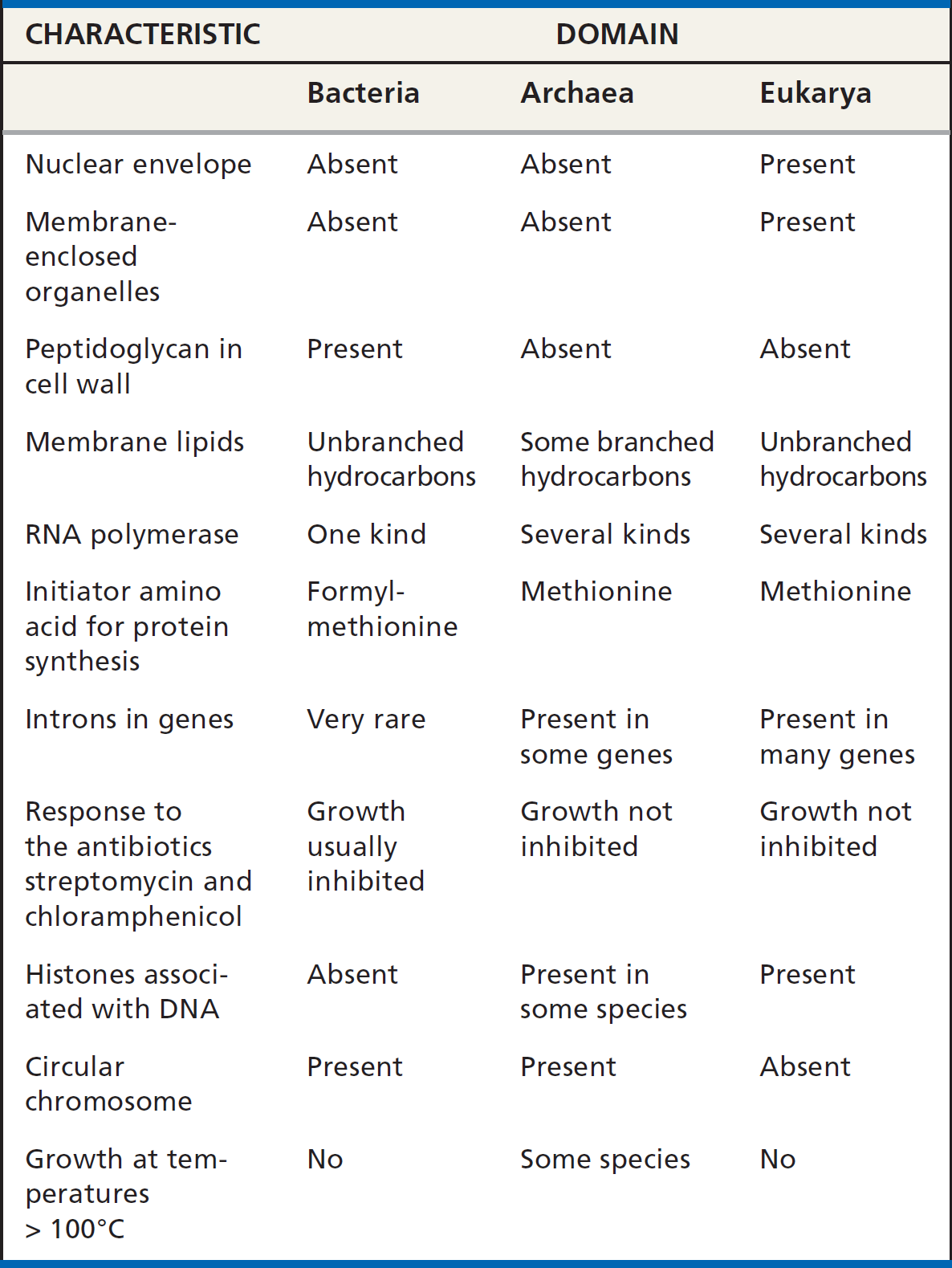
[[Extremophile:[[
An organism that lives in environmental conditions so extreme that few other species can survive there
What are examples of extremophiles?
Halophiles (salt lovers) and thermophiles (heat lovers)
[[Extreme Halophile:[[
AN organism that lives in a highly saline environment, such as the Great Salt Lake or the Dead Sea
[[Extreme Thermohile:[[
AN organism that thrives in hot environments (often 60-80*C or hotter)
Extreme thermophiles - Orange and yellow colonies of thermophilic prokaryotes grow in the hot water of Yellowstone National Park’s Grand Prismatic Spring
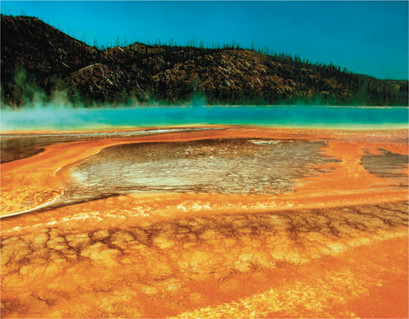
^^How might the enzymes of thermophiles differ from those of other organisms?^^
Thermophiles live in very hot environments, so it is likely that their enzymes can continue to function normally at much higher temperatures than can the enzymes of other organisms. At low temperatures, however, the enzymes of thermophiles may not function as well as the enzymes of other organisms
[[Methanogens:[[
AN organism that produces methane as a waste product of the way it obtains energy
All known methanogens are in the domain ___
Archaea
A highly thermophilic methanogen - The archaean Methanopyrus kandleri (inset) lives in the extreme heat of “black smoker” hydrothermal vents on the ocean floor
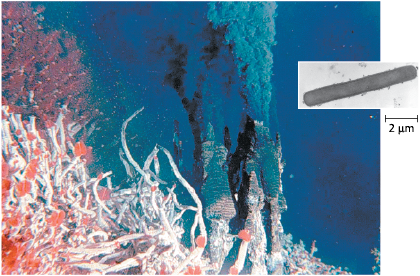
^^Explain how molecular systematics and metagenomics have contributed to our understanding of the phylogeny and evolution of prokaryotes^^
Molecular systematic studies indicate that some organisms once classified as bacteria are more closely related to eukaryotes and belong in a domain of their own: Archaea. Metagenomic studies have added many new branches to the prokaryotic tree of life, highlighting the extensive genetic diversity of these organisms. Genomic studies have also shown that horizontal gene transfer is common and plays an important role in the evolution of prokaryotes
^^What would the discovery of a bacterial species that is a methanogen imply about the evolution of the methane-producing pathway?^^
At present, all known methanogens are archaea in the clade Euryarchaeota; this suggests that this unique metabolic pathway probably arose in ancestral species within Euryarchaeota. Since Bacteria and Archaea have been separate evolutionary lineages for billions of years, the discovery of a methanogen from the domain Bacteria would suggest that adaptations that enabled the use of CO2 to oxidize H2 may have evolved twice—once in Archaea (within Euryarchaeota) and once in Bacteria. (It is also possible that a newly discovered bacterial methanogen could have acquired the genes for this metabolic pathway by horizontal gene transfer from a methanogen in domain Archaea. However, horizontal gene transfer is not a likely explanation because of the large number of genes involved and because gene transfers between species in different domains are rare.)
^^How have molecular data informed prokaryotic phylogeny?^^
Phenotypic criteria such as shape, motility, and nutritional mode do not provide a clear picture of the evolutionary history of the prokaryotes. In contrast, molecular data have revealed that prokaryotes form two domains (Bacteria and Archaea), and they have elucidated relationships among major groups of prokaryotes. Molecular data have also allowed researchers to sample genes directly from the environment; using such genes to construct phylogenies has led to the discovery of major new groups of prokaryotes
^^24.5 - Prokaryotes play crucial roles in the biosphere^^
Decomposition by heterotrophic prokaryotes and the synthetic activities of autotrophic and nitrogen-fixing prokaryotes contribute to the recycling of elements in ecosystems
Many prokaryotes have a symbiotic relationship with a host; the relationships between prokaryotes and their hosts range from mutualism to commensalism to parasitism
People depend on mutualistic prokaryotes, including hundreds of species that live in our intestines and help digest food
Pathogenic bacteria typically cause disease by releasing exotoxins or endotoxins. Horizontal gene transfer can spread genes associated with virulence to harmless species or strains
Prokaryotes can be used in bioremediation, production of biodegradable plastics, and the synthesis of vitamins, antibiotics, and other products
[[Decomposer:[[
An organism that absorbs nutrients from nonliving organic material such as corpses, fallen plant material, and the wastes of living organisms and converts them to inorganic forms; a detritivore
[[Cyanobacteria:[[
An autotrophic prokaryote that uses CO2 to make organic compounds such as sugars and produces atmospheric O2
Impact of bacteria on soil nutrient availability - Pine seedlings grown in sterile soils to which one of three strains of the bacterium Burkholderia glathei had been added absorbed more potassium (K+) than did seedlings grown in soil without any bacteria. Other results (not shown) demonstrated that strain 3 increased the amount of K+ released from mineral crystals to the soil
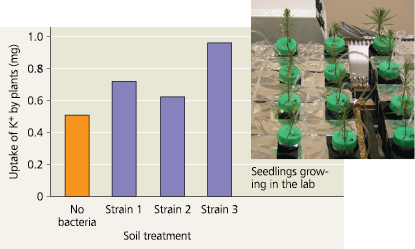
^^Estimate the average uptake of K+ for seedlings in soils with bacteria. What would you expect this average to be if bacteria had no effect on nutrient availability?^^
From the graph, plant uptake can be estimated as 0.7, 0.6, and 0.95 mg K+ for strains 1, 2, and 3, respectively. These values average to 0.75 mg K+. If bacteria had no effect, the average plant uptake of K+ for strains 1, 2, and 3 should be close to 0.5 mg K+, the value observed for plants grown in bacteria-free soil
[[Symbiosis:[[
An ecological relationship between organisms of two different species that live together in direct and intimate contact
[[Host:[[
The larger participant in a symbiotic relationship, often providing a home and food source for the smaller symbiont
[[Symbiont:[[
The smaller participant in a symbiotic relationship, living in or on the host
[[Mutualism:[[
A +/+ ecological interaction that benefits each of the interacting species
[[Commensalism:[[
A +/0 ecological interaction in which one organism benefits but the other is neither helped nor harmed
[[Parasitism:[[
A +/‒ ecological interaction in which one organism, the parasite, benefits by feeding upon another organism, the host, which is harmed; some parasites live within the host (feeding on its tissues), while others feed on the host’s external surface
[[Parasite:[[
An organism that feeds on the cell contents, tissues, or body fluids of another species (the host) while in or on the host organism. Parasites harm but usually do not kill their host
[[Pathogens:[[
An organism or virus that causes disease
Mutualism: bacterial “headlight” - The glowing oval below the eye of the flashlight fish (Photoblepharon palpebratus) is an organ harboring bioluminescent bacteria. The fish uses the light to attract prey and to signal potential mates. The bacteria receive nutrients from the fish
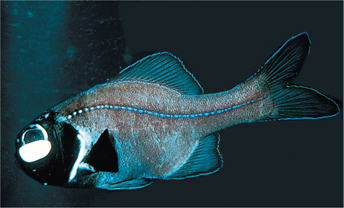
Are all prokaryotes bad for humans?
No, while some bacteria cause human illness others are helpful in agriculture and are positive
Lyme disease - Ticks in the genus Ixodes spread the disease by transmitting the spirochete Borrelia burgdorferi (colorized SEM). A rash may develop at the site of the tick’s bite; the rash may be large and ring-shaped (as shown) or much less distinctive
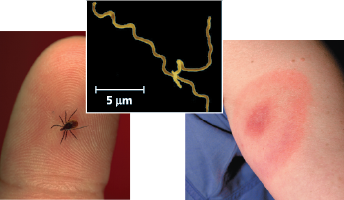
[[Exotoxin:[[
A toxic protein that is secreted by a prokaryote or other pathogen and that produces specific symptoms, even if the pathogen is no longer present
[[Endotoxins:[[
A toxic component of the outer membrane of certain gram-negative bacteria that is released only when the bacteria die
CRISPR: Opening new avenues of research on treating HIV infection - (a) In laboratory experiments, untreated (control) human cells were susceptible to infection by HIV, the virus that causes AIDS. (b) In contrast, cells treated with a CRISPR-Cas9 system that targets HIV were resistant to viral infection. The CRISPR-Cas9 system was also able to remove HIV proviruses (see Figure 17.8) that had become incorporated into the DNA of human cells
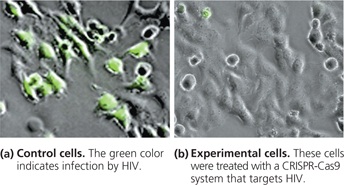
Products from prokaryotes - (a) These bacteria synthesize and store PHA, which can be extracted and used to make biodegradable plastic products. (b) Researchers are developing bacteria that produce ethanol (E-85) fuel from renewable plant products
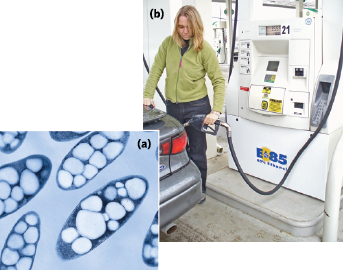
[[Bioremediation:[[
The use of organisms to detoxify and restore polluted and degraded ecosystems
Bioremediation of an oil spill - Spraying fertilizer stimulates the growth of native bacteria that metabolize oil, increasing the breakdown process up to fivefold
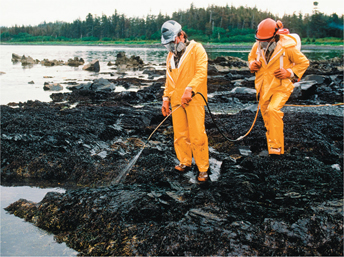
^^Explain how prokaryotes, though small, can be considered giants in their collective impact on Earth and its life^^
Although prokaryotes are small, their large numbers and metabolic abilities enable them to play key roles in ecosystems by decomposing wastes, recycling chemicals, and affecting the concentrations of nutrients available to other organisms. Prokaryotes also play a key role in ecological interactions such as mutualism and parasitism
^^A pathogenic bacterium’s toxin causes symptoms that increase the bacterium’s chance of spreading from host to host. Does this information indicate whether the poison is an exotoxin or endotoxin?^^
No. If the poison is secreted as an exotoxin, live bacteria could be transmitted to another person. But the same is true if the poison is an endotoxin—only in this case, the live bacteria that are transmitted may be descendants of the (now-dead) bacteria that produced the poison
^^Review photosynthesis in Figure 8.5. Then summarize the main steps by which cyanobacteria produce O2 and use CO2 to make organic compounds^^
Cyanobacteria produce oxygen when water is split in the light reactions of photosynthesis. The Calvin cycle incorporates CO2 from the air into organic molecules, which are then converted to sugars
^^How might a sudden, dramatic change in your diet affect the diversity of prokaryotic species in your gut?^^
Some of the many different species of prokaryotes that live in the human gut compete with one another for resources (from the food that you eat). Because different prokaryotic species have different adaptations, a change in diet may alter which species can grow most rapidly, thus altering species abundance
^^In what ways are prokaryotes key to the survival of many species?^^
Prokaryotes play key roles in the chemical cycles on which life depends. For example, prokaryotes are important decomposers, breaking down corpses and waste materials, thereby releasing nutrients to the environment, where they can be used by other organisms. Prokaryotes also convert inorganic compounds to forms that other organisms can use. With respect to their ecological interactions, many prokaryotes form life-sustaining mutualisms with other species. For example, human well-being depends on our associations with mutualistic prokaryotes, such as the many species that live in our intestines and digest food that we cannot. In some cases, such as hydrothermal vent communities, the metabolic activities of prokaryotes provide an energy source on which hundreds of other species depend; in the absence of the prokaryotes, the community collapses


